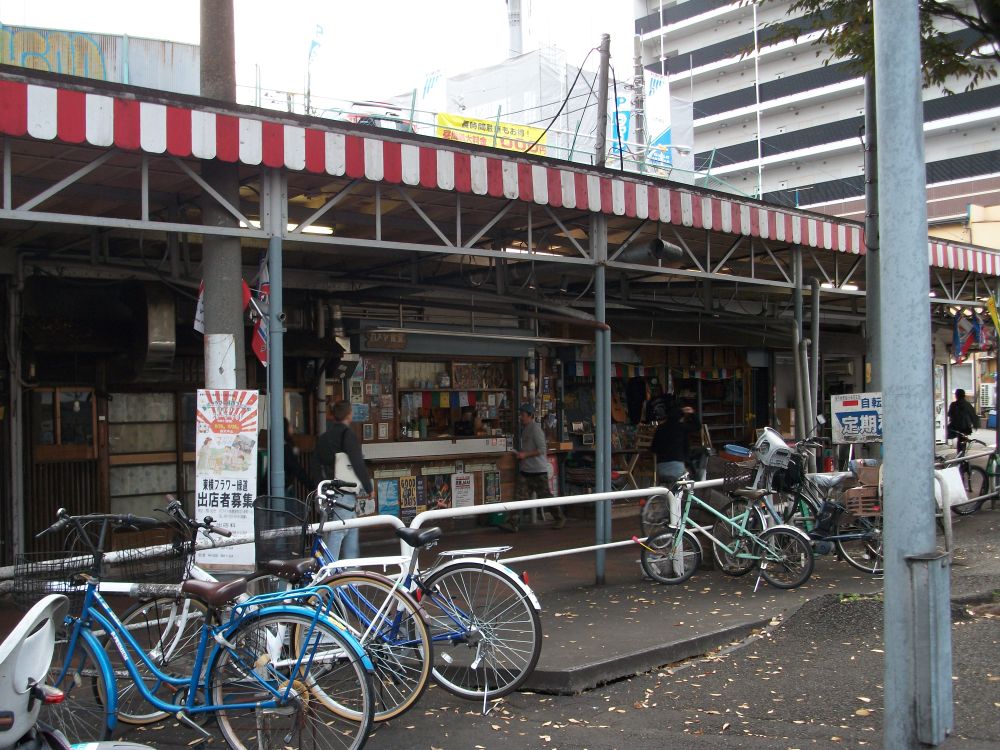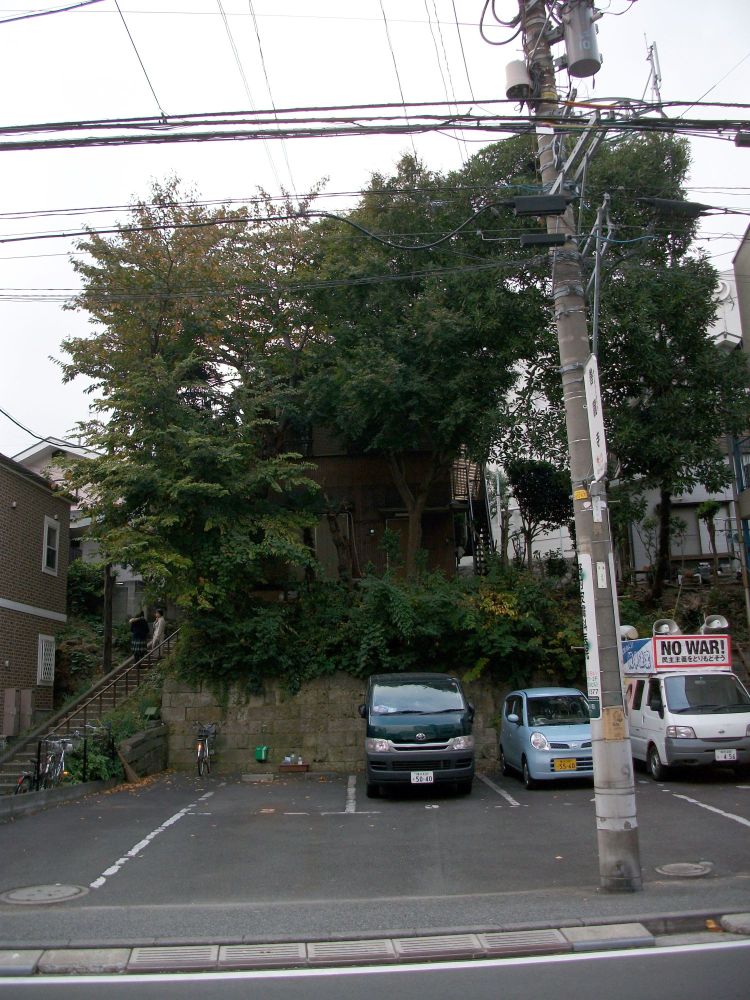Amari meni shinaimonowa (1) tsuzuki (1) : What is rarely seen is (1) sequel (1)
Le signe de route de la zone lampe
Le mot «zone lampe" a une impression d'un après divertissement sombre comme une barre de décrochage avec une lanterne rouge. Cependant, sa signification réelle semble encourager les gens à prendre en considération les usagers vulnérables.
Puisque la conception traditionnelle "Seigaiha (combinaison de caractères de couleur bleue, la mer, et les vagues) a été mentionné dans l'article précédant « Qu'est-ce que l'on voit rarement est ", j'ai fait une nouvelle recherche d'une photo plus claire du pont Kamidai. J'ai trouvé une photo de sa balustrade.
The road sign of the lamplight zone
The word "lamplight zone" has an impression of an after dark entertainment like a stall bar with a red lantern. However, its actual meaning seems to encourage people to give consideration to vulnerable road users.
Since the traditional design "Seigaiha (combination of characters of blue colour, the sea, and waves) was mentioned in the preceding article "What is rarely seen is", I made a further search for a more clear photo of Kamidai-bashi bridge. I found a photo of its balustrade.

Cette photo montre une partie du pont et de l'ancienne route de Tokaido dans une direction opposée à celle de la photo précédante. La motif de "Seigaiha" et un design plus rectiligne (je compte trouver son nom plus tard) au niveau des parties de faible hauteur aux deux extrémités du pont sont photographiés. Je suis impressionné par l'originalité et le bon sens des motifs traditionnelles.
Comme mentionné ci-dessus, la pente escalade sur la photo est une partie de l'ancienne route de Tokaido. Je prévois de visiter un point historique sur la route où j'ai entendu que les plaques d'explication et similaires sont placés. En faisant un virage à gauche à un coin directement après le pont (très légèrement montré sur la photo), il est possible d'atteindre une zone autour de la station Tanmach (la première station après la station de Yokohama lorsque vous prenez un train omnibus à destination de Shibuya ou un terminal plus loin de la ligne Fukutoshin, ligne Seibu ou ligne Tobu) de la ligne Toyoko après avoir progressé le long de la route, en passant thourgh les cornars à Sawatari et Izumi-cho passages.
Les quais de la gare Tanmachi de la ligne Toyoko sont maintenant sous-sol. L'installation souterraine a été achevée en 2004 lorsque la ligne Minato-Mirai a commencé ses opérations. Récemment, la fondation d'une footbrige restée en face de la station a été supprimée. Avant, il y avait des signes plutôt forts comme «Ceux qui n'utilisent pas le train est interdit d'entrer dans la zone de la station." Quand je suivais les directions, il serait apparu une situation comme "Oyashirazu Koshirazu (un dangereux côte bien connu de Niigata, probablement tros exagéré) :-).
This photo shows a part of the bridge and the ancient Tokaido road in a direction opposite to that of the previous photo. The design of "Seigaiha" and a more straight-lined design (I intend to find out its name later) at low-height portions at both ends of the bridge are photographed. I'm impressed by the originality and the good sense of the traditional design.
As mentioned above, the up-climbing slope in the photo is a part of the ancient Tokaido road. I plan to visit a historical point on the road where I heard that explanation plates and the like are placed.
By making a left-hand turn at a corner directly past the bridge (very slightly shown in the photo) , it is possible to reach an area around Tanmach station (the first station past Yokohama station when riding in a local train bound for Shibuya or a farther terminal of Fukutoshin line, Seibu line or Tobu line) of Toyoko line after advancing along the road, passing thourgh the cornars at Sawatari and Izumi-cho crossings.
The platforms of Tanmachi station of Toyoko line are now under-ground. The underground installation was completed in 2004 when Minato-mirai line started its operations. Recently, the foundation of a footbrige remained in front of the station has been removed. Before, there were rather strong signs like "Those who do not use the train are prohibited to enter into the area of the station." When I followed directions, there would have appeared a situation like "Oyashirazu Koshirazu (a well known dangerous hill-like coast of Niigata, very much exagerated probably) :-).

Cette photo montre une galerie marchande située à des dizaines de mètres à l'est de la station Tanmachi, dans lequel le restaurant Kameya est dans les parties centrales de l'arcade. Contrairement à son nom "restaurant", il n'y a pas d'entrée ni tables et chaises derrière le comptoir qui sont parfois visibles de la rue dans les cas habituels. Documents sur lesquels le nom du plat est écrit sont placés autour du comptoir, mais il semblait avoir besoin d'un courage d'être un custermer.
La réalité, que je l'appris plus tard, est que ce restaurant a ouvert ses portes en l'an 2012 et a une atmosphére amicale. J'ai aussi appris que, dans la journée, ce lieu est utilisé par un autre restaurant: Restaurant Wada dans lequel vous pouvez acheter une boîte à emporter le déjeuner. À la fin de l'année 2015, je me trouvais à passer par en face de ce restaurant où un groupe de nombreux «vous» s (dans l'expression d'un célèbre programme de télévision) et les populations locales (je suppose) écouter de la musique avec accompagnement de guitare. Je me sentais comme étant accidentellement il à la suite d'un temps de glisser.
La rue qui tourne sur le côté de la station Tanmachi et directement derrière le point où je pris la photo ci-dessus est la route nationale 1.
This photo shows a shopping arcade located at tens of meters east of Tanmachi station, in which Kameya restaurant is in the central parts of the arcade. Unlike its name "restaurant", there is not any entrance nor tables and chairs behind the counter that are sometimes visible from the street in usual cases. Papers on which the name of dish is written are placed around the counter, but it appeared to need a courage to be a custermer.
The reality, which I learned later, is that this restaurant was opened in the year of 2012 and has a friendly atmosphare. I also learned that In the day time, this place is used by another restaurant: Wada restaurant in which you can buy a take-out lunch box.
In the year end of 2015, I happened to pass by in front of this restaurant where a group of many "you"s (in the expression of a famous TV program) and local people (I guess) enjoying music with guitar accompaniment. I felt like accidentally being there as a result of a time slipping.
The street which runs on the side of Tanmachi station and directly behind the point where I took the photo shown above is National Road 1.

Lorsque vous allez le long la route nationale 1 après la station Tanmachi pendant un certain temps, il y aura un croisement (Hirodai ohta) près d'une caserne de pompiers et un des bâtiments complexes de bureaux municipaux de la préfecture de Kanagawa. Il y a un bâtiment d'une chaîne commerciale "Big Yosan" sur le côté opposé du passage à niveau. J'appris qu'il y avait une station de la ligne Toyoko nommé "Shin Ohta machi" il y a longtemps.
Après avoir fait un virage à gauche à ce passage pour entrer dans une route qui passe par "Hirakawa-cho» pour atteindre Nishi-Kanagawa 3 chome, propre à la fin d'un upslope long et doux, il existe un magasin de produits quotidiens nommés " Kato Shoten ". Probablement à cause de l'âge, la façade de la boutique me rend un peu nostalgique.
S'il y a une occasion appropriée, je voudrais acheter des biens dans cette boutique. Je reçois le sentiment que le sentiment de sécurité a prévalu dans la société quand les gens ne sont pas en mesure d'acheter des choses sans en parler à une personne dans la boutique.
When going along National Road 1 past Tanmachi station for a while, there will be a crossing (Hirodai ohta) near to a fire station and a complex buildings of municipal offices of Kanagawa prefecture. There is a building of a market chain "Big Yosan" on the opposite side of the crossing. I learned that there was a station of Toyoko line named "Shin Ohta machi" long time ago.
After making a left-hand turn at this crossing to enter a road which passes through "Hirakawa-cho" to reach Nishi-Kanagawa 3 chome, neat to the end of a long and mild upslope, there exist a shop of daily goods named "Kato Shoten." Probably because of the age, the facade of the shop makes me somewhat nostalgic.
If there is a suitable occasion, I would like to buy goods in this shop. I get the feeling that the sense of security prevailed in the society when the people were not able to buy things without talking to a person in the shop.

Derrière les arbres dans cette photo, il y avait une maison appartement sur un terrain à proximité de "rue commerçante Nishi-san" (nom court de Nishi Kanagawa 3 chome rue commerçante qui se connecte directement à "Rokkaku-bashi (meaing littéralement un pont hexagonale) panier rue). Il y a des escaliers raides sur le côté gauche de l'espace de stationnement. La paire de fenêtres de la maison d'appartements ressemblait yeux dans le visage humain, et m'a rappelé le film d'animation "Mon voisin Totoro." Malheureusement, cette maison appartement a été récemment détruite. Un point d'espoir est que les arbres restent comme avant.
À suivre.
Behind the trees in this photo, there was an appartment house on a lot near to "Nishi-san shopping street" (short name of Nishi Kanagawa 3 chome shopping street that directly connects to "Rokkaku-bashi (literally meaing a hexagonal bridge) shopping street). There are steep stairs on the left-hand side of the parking space. The pair of the windows of the apartment house looked like eyes in the human face, and reminded me of the animation film "My Neighbor Totoro." Unfortunately, this appartment house has been destructed recently. A hopeful point is that the trees remain as before.
To be continued.